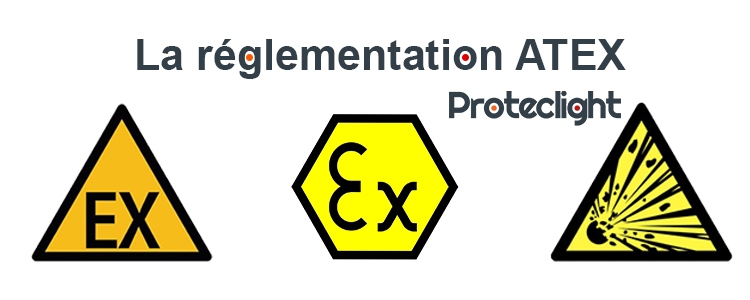
ATEX RegulationLeave a comment
Explanation and recommendation of equipment specifically intended for intervention in an explosive atmosphere.
What are ATEX regulations?
The ATEX regulation is a European directive aimed at controlling all dangers relating to explosive zones and atmospheres. The acronym ATEX stands for ATmosphères EXplosives and this regulation is the result of two directives on the same subject: ATEX 95, intended for the control of equipment that can be used in explosive areas, and ATEX 137, intended to ensure the safety of professionals in the performance of their duties.
The different classes and categories of explosive risk zones.
The ATEX regulations are compulsory for a large number of professionals exercising their function in areas with explosive atmospheres. Dangerous substances during professional interventions are as follows: Gases, vapours as well as flammable liquids, combustible dusts and flammable fibres and flying particles. These hazardous and flammable substances are frequently found in refineries and oil platforms, paint depots and spray booths, coal mines, ammunition factories, straw storage facilities, grain silos and ginneries as well as paper, textile and woodworking factories.
These hazardous areas are classified into three classes and three categories, each with an area designation.
- Class I: This zone class defines areas with the presence of flammable gases, vapours or liquids. The first zone category for these substances means the presence and certain danger of explosion when working in a hazardous and highly flammable area. This zone is called Zone 0. The second category, also called Zone 1, lists zones with a probable danger from an explosive atmosphere. The last category, also called Zone 2, is a zone with a low flammable hazard with a low probability of explosive hazards.
- Class II: This second class defines areas with combustible dusts such as metals, coal or cereal grains. The category listing the zones with a certain danger of the presence of flammable dust is called category 1 or zone 20. Category 2 (zone 21) lists working areas where the danger is not certain but probable. The last category of this class, called category 3 or zone 22, defines areas with a low risk and level of combustible dust in the air.
- Class III: This last zone class lists environments with the possible presence of flammable fibres and flying particles.

These European classifications, divided into 3 different categories and zones, are defined by their own characteristics.
- The zones associated with category 1 (zone 0 and zone 20) are environments with flammable materials for long periods, more than 1000 hours per year on average.
- Zones 1 and 21, associated with category 2, are areas with flammable materials present during normal operation, between 10 and 1000 hours per year.
- Category 3, less risky, represents zones 2 and 22 defined by a level of flammable materials present for less than 10 hours per year.
The products intended for interventions in ATEX zones proposed by Proteclight.
Our Proteclight online sales site, concerned about your safety, offers you a very wide range of products designed to operate in ATEX zones in complete safety. These products are luminous equipment from the PELI range, specialist in luminous signalling in areas with explosive atmospheres.
We present you the flagship products of the range, specially designed to work in ATEX zone.
The Peli 3315Z0 ATEX Zone 0 Torch: This torch is specially designed to be used in ATEX Zone 0 environment. Fluorescent yellow in colour, it is very easy to distinguish it from its non-regulated counterparts for working in an explosive atmosphere in Zone 0. It can also be clipped onto a protective helmet, so as not to be encumbered during a dangerous intervention.
The Peli 1975Z0 ATEX Zone 0 Torch: Smaller than its counterpart, this torch is just as powerful and practical. Light and discreet, it is easy to store thanks to its clip system, ideal for storing this torch in a pocket, like a pen.
Peli Headlamps 2765Z0 and 2690Z0: Headlamps for use in highly explosive ATEX zones are very practical for keeping a constant light in a confined space. These headlamps are approved and tested to be deployed in zone 0 without risk of deflagration.


The Peli 3415MZ0 Angled Flashlight: This flashlight, which can be used in ATEX zone 0, has the particularity of having an angled light orientation system, allowing a light diffusion on a precise and adjusted zone thanks to its removable head.
The ATEX 9415Z0 Zone Light: This ATEX 9415Z0 spotlight from the Peli range is recommended to illuminate a very wide area in explosive atmospheres. Thanks to its luminous angularity of 125° and the possibility of being rechargeable, this led floodlight is very powerful and allows a zone lighting for a duration of about 10. It also allows to illuminate a zone in height thanks to its foldable head, allowing to have a luminous height of more than 80cm.
Proteclight, at the service of your safety in ATEX explosive atmosphere.
Proteclight makes it a point of honour to guarantee you optimal safety during all your emergency interventions. For the exercise of your functions in a highly explosive area, our online site offers you a large number of products intended and approved for work in a flammable and explosive area with its numerous lighting systems from the Peli range. Click here to discover all our products for your lighting needs in ATEX zones.





Share your opinion!